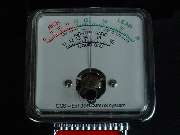
Chicagoland MG Club

Back to Archives
Submit an article
Cover
Intro & Club Officers
November Meeting Rept
Dues are Due
Left Hand Drive
Right Hand Drive
Welcome New Members
MG Midget Revival
Just a Simple Wrench
Fall Tune Down Party
Cruise to the Rock
Soapbox for CoChairman
Elections, Please Vote
CMGC Holiday Party
Camping at the BRIC
Alternator Conversion
Amtrak Road Trip
Driving Events Planning
9th All British Swapmeet
MGB Air Test Tweak
Classifieds
CMGC Events
Other Events
Back Cover
|
|
Modified 1978 MGB Air Test Tweak
October 30, 2004 - by Barney Gaylord
During the Grand Opening of United Classic Motors on October 16th, I had a hand in a thumbnail tune-up (no instruments) for an MGB prior to an emissions test. Sorry, but it failed. So we borrowed the Club’s new KAL exhaust gas analyzer, grabbed a timing light, and took a closer look. With Air/Fuel Ratio set to 14.5:1 at idle, and timing set to 10 degrees BTDC, it passed the air test easily.
I was curious to see why my thumbnail tuneup didn't get it through the air test the first time. (Yes I may be a little conceited). It was a ‘78 MGB (originally single Z-S carburetor and catalytic converter) converted to dual HS4 cabs with late style biased needles, '69-'70 vintage. The ‘69 MGB has a PCV valve, air pump and gulp valve. The ‘70 MGB also has a carbon canister. This car had no air pump or gulp valve and no PCV valve. The intake manifold ports were capped off, and the tappet cover vent was connected with a long hose routed below the frame as an early style draft tube.
Without the PCV valve hooked up, the absence of a little raw air into the manifold makes it run rich at idle. Adjusting the main jets leaner for good idle mixture makes it run too lean at all higher speeds. And indeed it drove like it was too lean at road speed, sluggish throttle response and occasional misfire on accelleration. With AFR set to 14.5 at idle, it was over 15.5:1 at road speed (close to 16.0:1).

This looks like it should have needles from a '62-'64 model to run well without PCV. But the earlier fixed needles don't fit the later carb with biased needles, so it would need special order biased needles, or a switch to earlier carburetors.
I thought I'd have a try at reinstalling the PCV plumbing to restore the small flow of raw air into the intake manifold. I connected the tappet cover hose to the intake manifold, and installed a 1/8" restrictor orifice in the valve cover breather connection. Then the carbs could be adjusted richer for good idle, and it ran better at higher speed. It would have been great, except for copious amounts of smoke out the exhaust that soon filled the garage. So I had to put it back the way it was and tell the owner to start planning on the engine overhaul to fix the bad rings and crankcase blow by problem. Meanwhile we compromize and adjust it slightly richer at idle so it doesn’t run too lean at speed.
The interresting bit here is that the new KAL exhaust gas analyzer makes it easy to see what happens to emissions (and air/fuel ratio) at various engine speeds. The Gunson’s Gas Tester (digital green box) we used before would give a reasonable readout of CO, but it wasn’t very intuitive about what was happening when the CO numbers might change at higher speed. The newer analyzer is checking CO as well, but rather than a digital readout it has an analog meter scale marked for Air/Fuel Ratio, which is easy to read and more intuitive. With engine speed changes you can watch the change in AFR. This instrument also has a fixture to attach the tail pipe sniffer to the car, so you can watch the results while you drive the car on the road.
|
|


